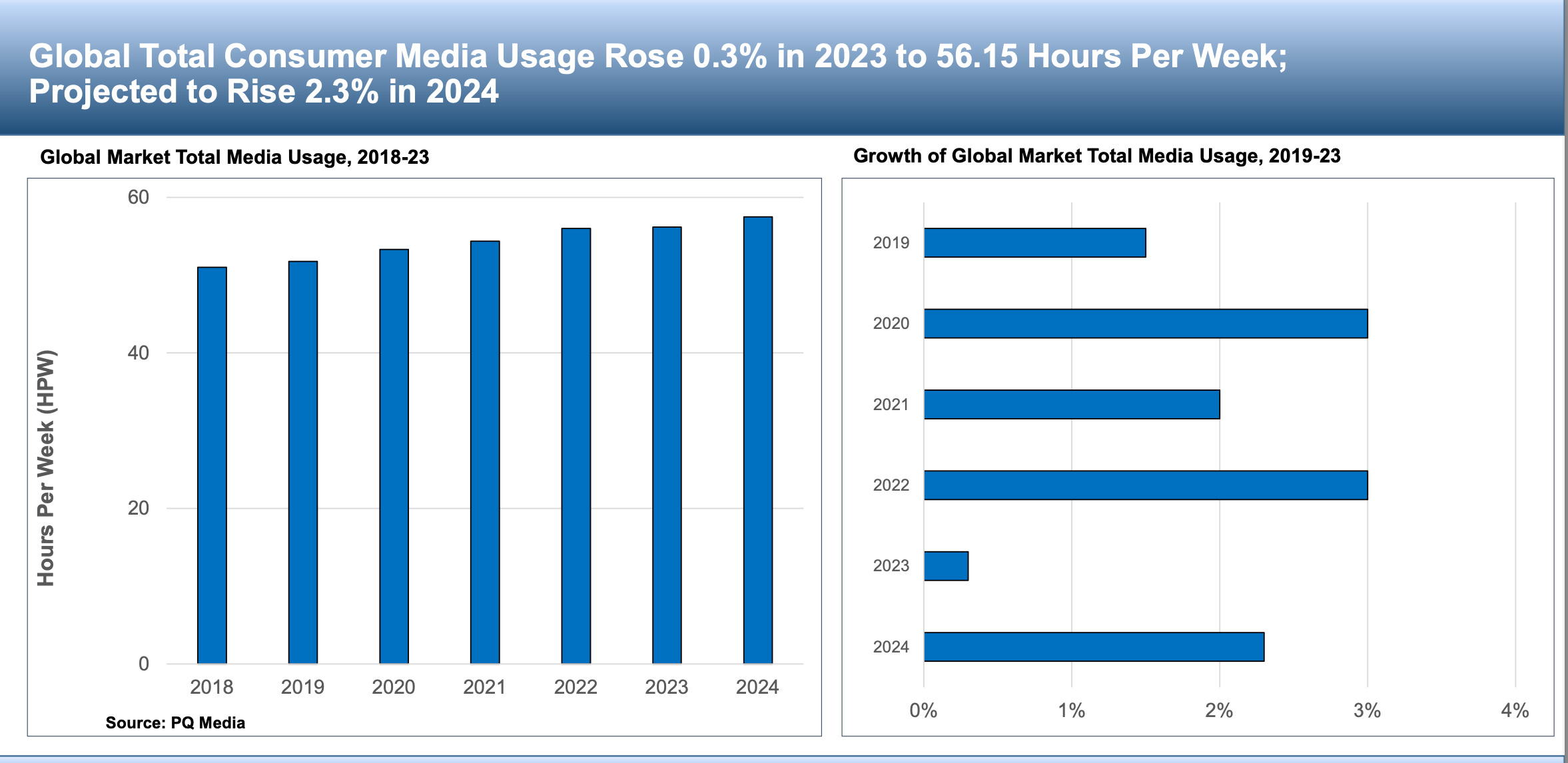Global consumer media usage grew only 0.3% in 2023, higher growth expected in 2024: PQ Media
By M4G Bureau - May 02, 2024
Consumer media usage grew at its slowest rate in more than a decade in 2023, some of which was the result of high inflation that caused consumers to cut discretionary spending on media like books, videogames, print subscriptions and streaming services, according to PQ Media’s 11th annual Global Consumer Media Usage Forecast 2024-2028.
Global consumer media usage, including all digital and traditional media channels, grew a slight 0.3% in 2023 to an average of 56.2 hours per week (HPW) in 2023, following a sharp growth acceleration in end-user time spent with media in 2022 of 3.0%, fuelled by major political elections in many of the top 20 global markets, as well as the Winter Olympics in China and the FIFA World Cup in Qatar, according to research released by PQ Media, the world’s leading provider of media econometrics.

The 2023 results show that media consumption is nearing PQ Media’s previously forecasted saturation point, as digital device penetration has almost peaked, and has begun posting declines in several major global markets, including the United States – the world’s largest media market. Consumer media usage grew at its slowest rate in more than a decade in 2023, some of which was the result of high inflation that caused consumers to cut discretionary spending on media like books, videogames, print subscriptions and streaming services, according to PQ Media’s 11th annual Global Consumer Media Usage Forecast 2024-2028.
“Media consumption, however, will post accelerated growth in 2024 with general elections in the United States, Mexico, Japan, Taiwan, India and South Africa, as well as the Summer Olympics in Paris, that will drive media usage rates in most of Western Europe that are in the same time zone or within an hour,” said PQ Media CEO Patrick Quinn. “In 2026, we’ll see this same phenomenon in the Americas when the United States, Mexico and Canada tri-host the FIFA World Cup and, again, in 2028 when the Summer Olympics are held in Los Angeles.”
The decelerating growth rate in 2023 was not unexpected, nor is the accelerated rise in 2024, as media consumption rates have fluctuated for decades between even and odd years, with the exception of years in which there are major economic recessions. That is, during a recession, media consumption rises as people are out of work and have more time to engage with media, and often use media as a cathartic tool to help alleviate the stress associated with hard times. Another trend which continued in 2023 is the shift from traditional media to digital media, with digital rising to command an overall market share of 37.5% globally, up from 27.0% in 2018.
While some of the part-time media researchers and industry trade newsletters might question this statistic as being too low, remember that both India and China have populations over 1 billion, with a high percentage living in poverty and unable to afford internet access and mobile phones, among other emerging nations with the same population profile. That said, there are many countries that digital media usage accounts for over 50% of total media consumption, such as South Korea, the Netherlands and Spain.
Among the six key generation groups tracked in the Global Consumer Media Usage Forecast 2024- 2028, i-Gens (born between 1996-2012) already exceed the 50% digital media usage threshold and Millennials (born between 1981 and 1996) will join them in 2024. Another reason that overall digital media usage is under 40% is due to the Great Generation (born before 1945), which are the heaviest media users worldwide at 86.51 hours weekly and use digital media only 27.4% of that time.
“With the rapid shift to digital media usage, 2022 will be the last year in which traditional media will ever post positive growth,” Quinn added. “While live sports, like the Super Bowl and UEFA Champions League, drive broadcast and cable TV usage, video streaming was the fastest growing media channel in 2023, some of which was driven by live sports programming now found on Amazon Prime’s Thursday Night Football, for example.” Meanwhile, growth in radio usage – the second most-used medium – is being driven by podcasting and streaming audio subscription services.
Among other key findings from the new report:
- The average global consumer spent 8.21 hours per day with media in 2023, up from 7.29 hours in 2018;
- Ad-supported media accounted for 53.3% of consumer time spent with media in 2023, down from a 55.8% in 2018, while in 11 markets, including the US, consumer-driven media exceeded 50%, led by Spain at 57.3%;
- From a demographic perspective, the Greatest Gen use media the most, while m-Gens (born after 2012) use media the least, averaging only 28.47 hours weekly in 2023;
- TV (including live, digital, streaming and OTT) video) remains the most used of the 11 video platforms PQ Media tracks, reaching 27.5 hours weekly last year, while film & home video posted the fastest growth, up 8.7%, fuelled by consumers returning to movie theatres, as more blockbusters were released compared with 2022;
- Mobile video posted the highest gain of the 22 digital channels, up 16.6% in 2023, while OTT video was the most used digital channel at 7.83 hours per week;
- Print books were the only traditional media platform to post growth in 2023, up 1.3%, a sharp deceleration from the 4.1% gain in 2022 when more bestsellers were released.

